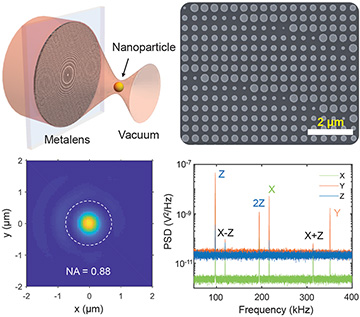 Top left: Artist view of optical levitation of a nanoparticle with a metalens in a vacuum. Top right: An SEM image of the metalens. Bottom left: Measured laser profile at the focus. The white dashed circle indicates the first dark ring of the Airy disk, corresponding to an NA of 0.88. Bottom right: Power-spectrum density (PSD) of a nanoparticle at a pressure of 2×10–4 Torr with linearly polarized optical tweezers. The trapping frequencies of x, y and z motions are about 216, 351 and 97 kHz. [Enlarge figure]
Top left: Artist view of optical levitation of a nanoparticle with a metalens in a vacuum. Top right: An SEM image of the metalens. Bottom left: Measured laser profile at the focus. The white dashed circle indicates the first dark ring of the Airy disk, corresponding to an NA of 0.88. Bottom right: Power-spectrum density (PSD) of a nanoparticle at a pressure of 2×10–4 Torr with linearly polarized optical tweezers. The trapping frequencies of x, y and z motions are about 216, 351 and 97 kHz. [Enlarge figure]
Pioneered by Arthur Ashkin, optical tweezers are widely applied in multiple research fields, including biology and physics. In particular, an optically levitated nanoparticle in vacuum is excellent for sensing and testing fundamental physics due to its ultrahigh mechanical quality factor.1
To optically trap a nanoparticle in vacuum, a laser beam is often tightly focused by a bulky objective lens with a high numerical aperture (NA), or by a pair of lenses if the NA of the individual lenses is not high enough. The system is unwieldy and inconvenient for practical applications, such as portable accelerometers. A growing demand exists to reduce the size of the focusing lens and bring levitation of a dielectric particles to the chip scale for better performance and efficiency.
In recent work, we showed optical levitation of nanoparticles in vacuum with a metalens for the first time,2 using a planar metalens, which can be far smaller than a conventional objective lens.3 We designed and fabricated—with 500-nm-thick amorphous silicon, which is compatible with ultrahigh vacuum—a dielectric metalens with a focal length of 100 µm and a high NA of 0.88 for a 1064-nm laser in vacuum. We then used a single-metalens optical-tweezer setup, at a pressure of 2×10–4 Torr, to levitate a silica nanoparticle without feedback cooling. We were also able to transfer a levitated nanoparticle between two optical tweezers separated by about 1.5 µm.
Our metalens for optical trapping in vacuum has a higher NA than one used in more recent experiments involving optical trapping in liquids.4 The refractive-index contrast of a nanoparticle in vacuum is larger than in liquids; hence, a larger NA is necessary for optical trapping in vacuum with a single metalens. Optical levitation with a metalens provides opportunities for on-chip quantum-limited sensing. Such a metalens can also trap a single atom in vacuum for quantum information science.5
Researchers
Kunhong Shen, Peng Ju, Zhujing Xu, Jonghoon Ahn and Tongcang Li, Purdue University, West Lafayette, IN, USA
Yao Duan, Xi Chen, Lidan Zhang and Xingjie Ni, The Pennsylvania State University, University Park, PA, USA
References
1. C. Gonzalez-Ballestero et al. Science 374, eabg3027 (2021).
2. K. Shen et al. Optica 8, 1359 (2021).
3. M. Khorasaninejad et al. Science 352, 1190 (2016).
4. G. Tkachenko et al. Opt. Lett. 43, 3224 (2018).
5. T.-W. Hsu et al. PRX Quantum 3, 030316 (2022).
